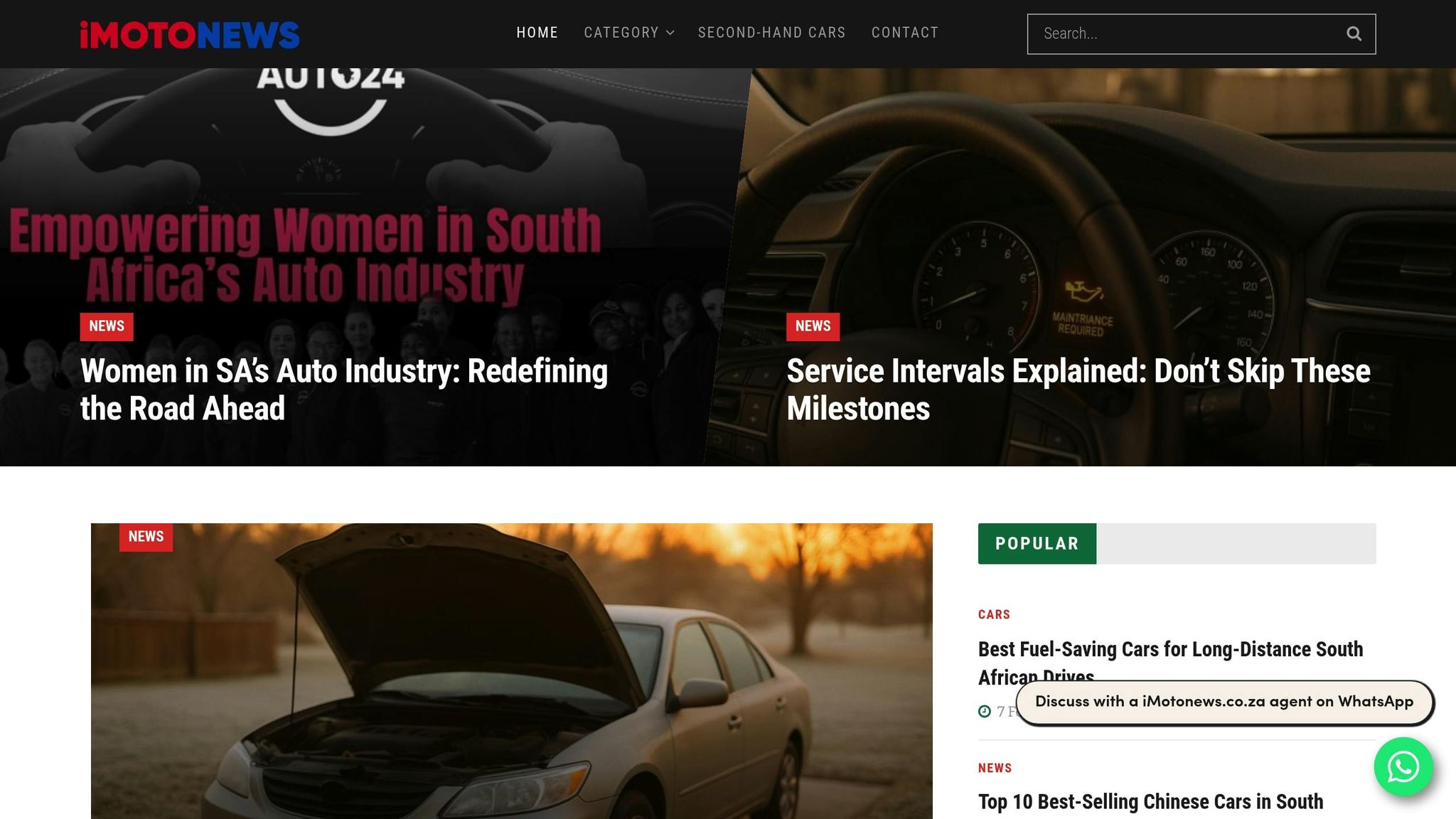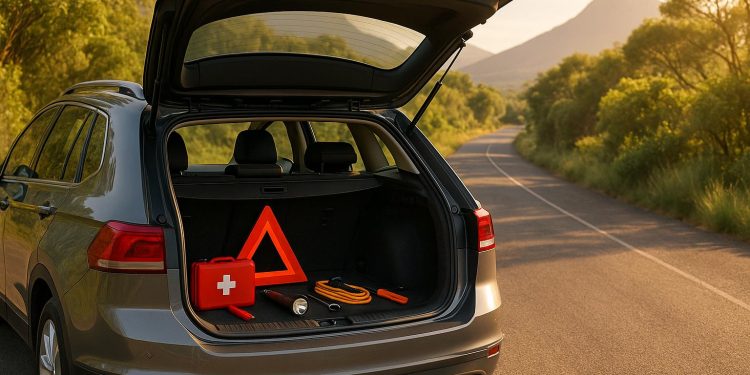December is peak travel time in South Africa, with millions hitting the roads for summer getaways. To stay safe and avoid breakdowns, prepping your car is non-negotiable. Here’s what you need to know:
- Tires & Brakes: Check tire pressure, tread depth, and spare tire condition. Inspect brakes for wear or unusual noises.
- Fluid Levels: Ensure engine oil, coolant, and windshield washer fluid are topped up. Low levels can lead to overheating or poor visibility.
- Battery & Lights: Test battery voltage and clean terminals. Check headlights, indicators, and wipers for proper function.
- Emergency Kit: Include essentials like a warning triangle, first aid supplies, jumper cables, a fire extinguisher, and basic tools.
- Route & Weather: Plan your route with rest stops and monitor weather conditions. Avoid driving at night or in extreme weather.
Proper preparation ensures a safer, smoother trip. Schedule a professional inspection and save emergency contacts for added peace of mind. Safe travels!
How to Prep Your Car for a Summer Road Trip! – KID APPROVED!
Basic Car Maintenance Checks
Before packing your bags and heading out on South Africa’s diverse holiday routes, take some time to inspect your car. A little preparation can go a long way in ensuring your vehicle stays dependable throughout your journey.
Check Tires and Brakes
Tires are your first line of defense against varying road conditions. Start by checking the tire pressure as outlined in your owner’s manual – these guidelines are especially important when your car is fully loaded for holiday travel. Don’t forget to inspect your spare tire as well [17, 18].
Look over each tire for signs of damage and check the tread depth using a coin. If the top of the coin is visible, it’s time to replace the tire. This becomes even more important as South Africa plans to implement new roadworthiness advisories in 2025 to help reduce holiday travel disruptions.
Your brakes are just as critical, particularly with the increased traffic and longer distances that come with holiday road trips. Pay attention to how they feel while driving. If they seem "spongy" or require extra pressure, it’s a sign to have them inspected by a professional. Unusual noises like grinding or squealing could mean the brake pads are worn. Keeping your brakes in good condition is key to staying safe on busy roads.
Check Fluid Levels
Fluids are essential for your car’s performance, and checking them weekly before your trip can help you avoid costly breakdowns. Start with engine oil. Park the car on level ground, let the engine cool for about five minutes, then pull out the dipstick. Wipe it clean, reinsert it, and check the oil level – it should sit between the minimum and maximum marks. If it’s low, top it up with the correct grade of oil using a funnel. As experts warn, "Always make sure you use the correct fluids when topping up – never mix different grades of engine oil and brake fluid".
Next, check the coolant level in the expansion tank while the engine is cold. The fluid should be between the MAX and MIN marks. If it’s low, add a 50/50 mix of water and antifreeze. Don’t overlook the windshield washer fluid, which is essential for clear visibility on dusty roads. Locate the reservoir (usually marked with a windshield symbol) and fill it completely. If you notice any fluid levels dropping consistently, it could indicate a leak that needs professional attention. Proper fluid levels help prevent overheating and ensure clear visibility during long drives.
Test Battery and Electrical System
Battery issues are responsible for nearly half of all car breakdowns, so this check is crucial. Start with a visual inspection, looking for corrosion on the terminals, cracks in the battery case, or loose connections. Use a multimeter to measure the voltage with the engine off – a healthy battery should read between 12.4V and 12.7V. If it’s below 12.2V, the battery may be weak, and anything under 12V likely means it needs charging or replacing. To test the alternator, start the car and check the voltage again – it should rise to between 13.7V and 14.7V.
Clean corroded terminals monthly with a mix of baking soda and water or a commercial terminal cleaner, and make sure all connections are secure. Low temperatures can sap 30–60% of battery power, so if your battery is nearing the end of its 3–5 year lifespan, it’s wise to replace it before your trip.
Finally, test all lights, indicators, and wipers to ensure they’re working properly. A reliable electrical system is essential for a safe and trouble-free holiday drive.
Pack an Emergency Kit for Road Safety
Regular car maintenance keeps your vehicle running smoothly, but an emergency kit is your safety net for unexpected situations. It can turn a potential disaster into a temporary inconvenience. With South African roads recording 1,451 fatalities during the 2022/2023 festive season, being ready for emergencies is not just smart – it’s essential. Tailor your kit to suit the length of your journey, the areas you’ll be driving through, and the weather you might face. Here’s what you should include.
Essential Emergency Items
Your kit should start with the basics. Always have a reflective warning triangle in your car, especially since accident risks are higher between 7:00 PM and 8:00 PM. A well-stocked first aid kit is non-negotiable. Include bandages, antiseptic wipes, pain relievers, and any personal medications you might require.
For minor roadside fixes, pack jumper cables, a spare tire, a jack, a lug wrench, and basic tools like screwdrivers, pliers, and an adjustable wrench. A windscreen chip repair kit and tire filler can help you handle common road issues until professional assistance is available.
Additionally, a fire extinguisher designed for vehicles is a must. Make sure it’s mounted securely and that everyone in your household knows how to use it. Vehicle fires can happen without warning, so being prepared is crucial.
Extra Items for Comfort and Safety
Beyond the essentials, include items to keep you comfortable and safe during delays. Stock up on water and non-perishable snacks like energy bars or dried fruit to stay nourished.
A fully charged power bank and car-compatible phone chargers can keep you connected, even during power outages.
If your route takes you through areas prone to extreme weather – like KwaZulu-Natal, which experiences heavy rainfall and occasional snow – pack warm blankets, Mylar emergency blankets, and hand warmers. A foldable shovel and tire traction mats can come in handy if you face snowy or icy conditions.
"Preparation is key to a safe journey." – Red Alert Service Solution
For long waits or tricky repairs, practical tools like a multi-tool, duct tape, zip ties, and work gloves can make a big difference. These items are versatile and can help you tackle various unexpected challenges.
LED vs. Incandescent Flashlights
A reliable flashlight is a critical part of any emergency kit, and choosing between LED and incandescent models can impact how prepared you are when it matters most.
| Feature | LED Flashlights | Incandescent Flashlights |
|---|---|---|
| Energy Efficiency | Use 75–90% less energy | Convert only 2% of energy to light, wasting 98% as heat |
| Lifespan | 25,000–50,000 hours | 1,000–2,000 hours |
| Brightness | Up to 1,000+ lumens | Usually under 100 lumens |
| Durability | Impact and water-resistant options | Fragile glass bulbs |
| Battery Life | Extended runtime due to low power consumption | Reduces battery life |
| Initial Cost | Slightly higher upfront cost | Lower initial purchase price |
| Light Quality | Cool white or adjustable color options | Warm yellow light |
LED flashlights outperform their incandescent counterparts in nearly every category. They last up to 25 times longer, consume far less energy, and are more durable. This makes them the go-to choice for emergency kits, ensuring they’ll work when you need them, even after months of storage.
For the best performance, pair LED flashlights with lithium batteries, as they hold up better in extreme temperatures.
Prepare for South African Road Conditions
Driving in South Africa during December requires a bit of extra planning. With 13,133,035 registered vehicles on the road during the 2023/2024 festive season – 168,000 more than the previous year – traffic congestion is a real challenge. The numbers tell a sobering story: 1,184 fatal crashes were recorded during this period, with human error responsible for 80.8% of them. By planning ahead and preparing for the weather, you can make your journey safer and less stressful.
Plan Your Route
A well-planned route is as important as a well-maintained vehicle. Use GPS to map your journey, including rest stops, fuel stations, and overnight accommodations. GPS apps with real-time traffic updates can help you avoid congestion, construction zones, and even accident sites – issues that are all too common during the busy holiday season. To steer clear of peak traffic, consider driving in the mid-morning or early afternoon.
Before hitting the road, check your itinerary with reliable local sources like hotels, travel agents, or even the local police. They can provide up-to-date information on road conditions, construction work, or areas to avoid. Whenever possible, avoid driving after dark, as reduced visibility and fatigue significantly increase the risk of accidents.
Once your route is set, be ready to adapt to changing weather and terrain.
Prepare for Weather and Terrain
December weather in South Africa is unpredictable. Along the coast and in the Eastern Cape, you’ll likely encounter hot days punctuated by sudden thunderstorms. Northeastern regions, including Johannesburg and Kruger National Park, experience their wet season, with high humidity and frequent afternoon showers.
To prepare for these conditions, check your tires, windshield wipers, and fluid levels. Tires with adequate tread are essential for navigating wet roads safely, especially since 10.4% of crashes during this period are linked to environmental factors like storms and heavy rain. Don’t overlook your windshield wipers – worn blades can make sudden downpours much more dangerous.
South African roads range from congested city streets to remote rural routes, each presenting unique challenges. If rain starts, slow down, increase your following distance, and turn on your headlights to improve visibility for yourself and others.
Hot weather brings its own set of issues. Before you leave, make sure your vehicle’s fluid levels are topped up, and carry extra coolant and water. Stay hydrated and take regular breaks to cool off during the hottest parts of the day.
Stay alert, especially on rural roads where pedestrians, cyclists, and even wildlife can appear without warning. This kind of awareness is especially important when weather conditions shift unexpectedly. By staying prepared and vigilant, you can navigate South Africa’s roads with confidence this holiday season.
sbb-itb-09752ea
Stay Comfortable and Safe During Long Drives
Long drives, especially during South Africa’s busy December holiday season, require more than a reliable vehicle. They demand careful planning to ensure both comfort and safety for drivers and passengers alike. With drowsy driving contributing to nearly 100,000 crashes annually in the U.S., staying alert and comfortable is not just a good idea – it’s essential. The goal is to create an environment that keeps everyone focused and refreshed for the entire journey.
Optimize In-Cabin Comfort
Start by adjusting your seat, mirrors, and steering wheel to positions that feel natural and comfortable. Your seat should allow your knees to remain slightly bent when pressing the pedals, and your mirrors should be set to eliminate blind spots without requiring you to shift or stretch awkwardly. Keep the steering wheel at a distance where you can comfortably grip it with relaxed shoulders resting against the seat back.
Maintaining a cool cabin temperature can help reduce drowsiness. Organize your space by keeping entertainment devices and charging cables neatly arranged. Snacks and water bottles should be within easy reach, ideally placed near the front passenger, who can assist in handing them out to back-seat travelers.
When it comes to snacks, opt for protein-packed options like nuts, jerky, or cheese sticks, paired with water to avoid the energy dips caused by sugary treats. Once your setup is sorted, plan for regular breaks to keep everyone alert and energized.
Take Regular Rest Stops
"Stop to take breaks during long trips every two hours or 100 miles". These breaks should include some form of light physical activity, like stretching or walking, to improve circulation and combat fatigue.
If you’re sharing the driving, plan driver rotations ahead of time. Taking turns behind the wheel with another licensed driver can significantly reduce fatigue and help everyone stay more focused. When it’s your turn to rest, use the time wisely – close your eyes, stretch, or take a short nap if needed.
If fatigue becomes overwhelming, consider a 15- to 45-minute nap. While caffeine can offer a quick energy boost, its effects are temporary, so plan for proper rest within a few hours of consuming it. Avoid pushing through extreme tiredness, as drowsiness can impair anyone, from young drivers to seasoned road warriors.
Keep Travel Documents Ready
Comfort isn’t just physical – it’s also about peace of mind. Ensure your driver’s license, vehicle registration, and insurance documents are easily accessible. Store them in the glove compartment or a dedicated folder, avoiding the trunk for convenience.
For South African citizens over 18, domestic travel requires government-issued identification, such as an ID book, passport, driver’s license, or refugee ID. Non-South African passport holders should confirm their passport includes at least one blank visa page for entry and exit stamps.
As a precaution, keep copies of these important documents separate from the originals. Save digital versions on your phone or in cloud storage, and leave physical copies with someone you trust back home. This simple backup plan can save you a lot of stress if anything goes missing during your trip.
Use Trusted Local Resources
Having access to professional assistance and accurate information can make all the difference between a hassle-free road trip and an unexpected roadside emergency. South Africa offers a variety of trusted services designed to keep drivers safe and informed, complementing the preventive steps you’ve already taken to prepare your car for holiday travel.
Get a Professional Inspection
Before embarking on your December holiday, it’s a smart move to schedule a professional car inspection at a trusted workshop. Services like Bosch Car Service and DEKRA Technical Inspection provide detailed, impartial evaluations of your car’s condition. Regular maintenance and pre-trip checks not only ensure your vehicle’s safety but may also help improve fuel efficiency.
"A DEKRA Condition Report will help prevent post-sales disputes by documenting your car’s condition at the time of sale. With a thorough, unbiased report in hand, buyers know exactly what they’re getting, reducing the chances of any claims or issues arising after the deal is done." – DEKRA Automotive South Africa
When arranging an inspection, ask the technicians to focus on areas critical for long trips, such as the brakes, suspension, cooling system, and electrical components. These checks can give you peace of mind for the journey ahead.
ImotoNews South Africa as a Resource

For up-to-date automotive news, maintenance tips, and travel advice tailored to South African drivers, ImotoNews South Africa is a valuable resource. This online platform covers a variety of topics, from car care tips to detailed travel guides, helping you make informed decisions about your vehicle and your holiday plans. Articles like "Road Trip Readiness" and "Navigating South Africa: A Travel Guide" provide practical advice to ensure your trip goes smoothly.
ImotoNews South Africa also offers a WhatsApp service for instant support. Whether you need advice on handling tricky road conditions or want to learn about the latest maintenance techniques, this feature makes it easy to get quick answers to your questions.
Keep Roadside Assistance and Emergency Contacts
Even with expert inspections and reliable information, having access to emergency contacts is essential. Save these numbers under "Emergency Contacts" on your phone and share the list with family or friends. Key numbers to have on hand include:
- 112 for general emergencies
- 10111 for police assistance
- 10177 for ambulance/fire services
- ER24 (084 124)
- Netcare 911 (082 911)
- Life Healthcare (0860 532 532)
- AA Roadside Assistance (0861 000 234)
- Road Traffic Management Corporation (0861 400 800)
Additionally, mobile apps like Namola and mySOS provide real-time emergency assistance and GPS-linked support, offering another layer of safety during your travels.
"Emergencies can happen when we least expect them, and knowing who to call can be lifesaving." – Simbulele Jezile, BackaBuddy
Conclusion: Ready for the December Holidays
With thoughtful preparation, your vehicle is set to handle the demands of December travel. Those careful pre-trip checks you’ve done aren’t just routine – they’re your first line of defense against potential road troubles. These steps can make the difference between a smooth, enjoyable trip and an unexpected breakdown.
According to the National Highway Traffic Safety Administration, nearly 5% of all road accidents are linked to neglected vehicle maintenance. That’s a sobering reminder of how critical these efforts are. By testing your battery, checking your brakes, and ensuring your cooling system is in good shape, you’re actively working to avoid becoming part of that statistic.
Your emergency kit is your safety backup, ready to step in when surprises arise. Planning your route and knowing where fuel stations are located adds an extra layer of security to your journey.
Once you’ve completed your inspection and saved emergency contacts, you’re fully prepared. And with resources like ImotoNews South Africa offering expert guidance, you have reliable support at your fingertips whenever needed.
"Regular upkeep not only ensures a smooth and enjoyable journey but also plays a pivotal role in safeguarding your life and the lives of others on the road. Remember, a well-maintained vehicle is a safer vehicle. Happy travels!" – Alonso Gomez, Author
This advice underscores how essential preparation is for handling different road conditions. Whether you’re navigating coastal highways or winding through mountain passes, the effort you’ve put into getting your car ready will reward you with peace of mind, safety, and reliability throughout your December holiday travels. Drive carefully, take breaks when needed, and enjoy every moment of the journey ahead.
FAQs
What challenges do drivers in South Africa face during the December holidays, and how can I get my car ready for safe travel?
During the December holiday season in South Africa, traffic congestion becomes a common challenge, particularly on major highways like the N1, N2, and N3. Unfortunately, the risk of accidents also spikes during this period, often due to fatigue, speeding, reckless driving, and alcohol consumption. Some routes, such as the R71 in Limpopo and the R37 in Mpumalanga, are especially notorious for being dangerous during this time.
To ensure a safer journey, start by making sure your vehicle is in good shape. Check tire pressure, oil levels, and battery condition before hitting the road. It’s also wise to pack an emergency kit with essentials like a flashlight, first aid supplies, and basic tools. Plan your route ahead of time, try to avoid peak traffic hours, and take regular breaks to stay focused and refreshed. These precautions can make your holiday travels less stressful and much safer.
How do I make sure my car battery is ready for a holiday road trip?
Before hitting the road, make sure your car battery is in top shape. Start by using a multimeter to check the voltage. A healthy, fully charged battery should show a reading between 12.6 and 12.8 volts when the engine is off. Next, inspect the battery terminals for any corrosion, loose connections, or dirt. If you spot any issues, clean the terminals or tighten the connections as needed.
If your battery is more than three years old, it’s a good idea to have it tested by a professional to confirm it’s still reliable. These simple checks can help you avoid unexpected battery trouble and ensure a smooth, worry-free trip.
What should I pack in an emergency kit for a road trip in South Africa, and why is it important?
Packing an emergency kit is a smart move to ensure you’re ready for anything during a road trip in South Africa. Make sure your kit includes essentials like a first aid kit, jumper cables, reflective warning triangles, a flashlight with spare batteries, a multi-tool, a tow rope, and safety gloves. These basics can help you manage typical roadside challenges, whether it’s a flat tire, minor injuries, or a dead battery.
It’s also a good idea to bring along extra water, non-perishable snacks, a phone charger, and a basic repair toolset. These additions can make a big difference if you face unexpected delays or emergencies. Being prepared not only keeps you safe but also helps make your journey smoother and more enjoyable.
Related posts
- Fuel-Saving Tips for Long South African Road Trips
- 7 Winter Car Care Tips for South Africa
- 5 Romantic Coastal Drives in South Africa
- Car maintenance costs in South Africa





